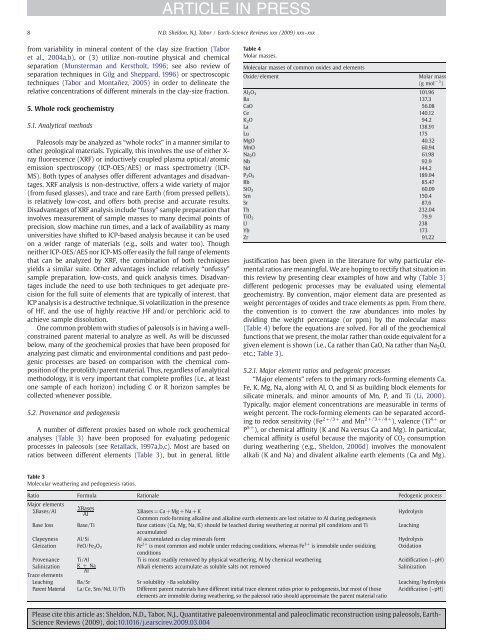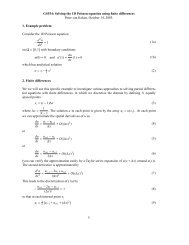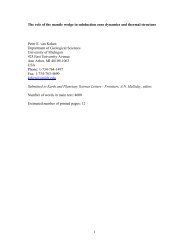Quantitative paleoenvironmental and paleoclimatic reconstruction ...
Quantitative paleoenvironmental and paleoclimatic reconstruction ...
Quantitative paleoenvironmental and paleoclimatic reconstruction ...
You also want an ePaper? Increase the reach of your titles
YUMPU automatically turns print PDFs into web optimized ePapers that Google loves.
ARTICLE IN PRESS<br />
8 N.D. Sheldon, N.J. Tabor / Earth-Science Reviews xxx (2009) xxx–xxx<br />
from variability in mineral content of the clay size fraction (Tabor<br />
et al., 2004a,b), or (3) utilize non-routine physical <strong>and</strong> chemical<br />
separation (Munsterman <strong>and</strong> Kerstholt, 1996; see also review of<br />
separation techniques in Gilg <strong>and</strong> Sheppard, 1996) or spectroscopic<br />
techniques (Tabor <strong>and</strong> Montañez, 2005) in order to delineate the<br />
relative concentrations of different minerals in the clay-size fraction.<br />
5. Whole rock geochemistry<br />
5.1. Analytical methods<br />
Paleosols may be analyzed as “whole rocks” in a manner similar to<br />
other geological materials. Typically, this involves the use of either X-<br />
ray fluorescence (XRF) or inductively coupled plasma optical/atomic<br />
emission spectroscopy (ICP-OES/AES) or mass spectrometry (ICP-<br />
MS). Both types of analyses offer different advantages <strong>and</strong> disadvantages.<br />
XRF analysis is non-destructive, offers a wide variety of major<br />
(from fused glasses), <strong>and</strong> trace <strong>and</strong> rare Earth (from pressed pellets),<br />
is relatively low-cost, <strong>and</strong> offers both precise <strong>and</strong> accurate results.<br />
Disadvantages of XRF analysis include “fussy” sample preparation that<br />
involves measurement of sample masses to many decimal points of<br />
precision, slow machine run times, <strong>and</strong> a lack of availability as many<br />
universities have shifted to ICP-based analysis because it can be used<br />
on a wider range of materials (e.g., soils <strong>and</strong> water too). Though<br />
neither ICP-OES/AES nor ICP-MS offer easily the full range of elements<br />
that can be analyzed by XRF, the combination of both techniques<br />
yields a similar suite. Other advantages include relatively “unfussy”<br />
sample preparation, low-costs, <strong>and</strong> quick analysis times. Disadvantages<br />
include the need to use both techniques to get adequate precision<br />
for the full suite of elements that are typically of interest, that<br />
ICP analysis is a destructive technique, Si volatilization in the presence<br />
of HF, <strong>and</strong> the use of highly reactive HF <strong>and</strong>/or perchloric acid to<br />
achieve sample dissolution.<br />
One common problem with studies of paleosols is in having a wellconstrained<br />
parent material to analyze as well. As will be discussed<br />
below, many of the geochemical proxies that have been proposed for<br />
analyzing past climatic <strong>and</strong> environmental conditions <strong>and</strong> past pedogenic<br />
processes are based on comparison with the chemical composition<br />
of the protolith/parent material. Thus, regardless of analytical<br />
methodology, it is very important that complete profiles (i.e., at least<br />
one sample of each horizon) including C or R horizon samples be<br />
collected whenever possible.<br />
5.2. Provenance <strong>and</strong> pedogenesis<br />
A number of different proxies based on whole rock geochemical<br />
analyses (Table 3) have been proposed for evaluating pedogenic<br />
processes in paleosols (see Retallack, 1997a,b,c). Most are based on<br />
ratios between different elements (Table 3), but in general, little<br />
Table 4<br />
Molar masses.<br />
Molecular masses of common oxides <strong>and</strong> elements<br />
Oxide/element<br />
Molar mass<br />
(g mol − 1 )<br />
Al 2 O 3 101.96<br />
Ba 137.3<br />
CaO 56.08<br />
Ce 140.12<br />
K 2 O 94.2<br />
La 138.91<br />
Lu 175<br />
MgO 40.32<br />
MnO 60.94<br />
Na 2 O 61.98<br />
Nb 92.9<br />
Nd 144.2<br />
P 2 O 5 189.94<br />
Rb 85.47<br />
SiO 2 60.09<br />
Sm 150.4<br />
Sr 87.6<br />
Th 232.04<br />
TiO 2 79.9<br />
U 238<br />
Yb 173<br />
Zr 91.22<br />
justification has been given in the literature for why particular elemental<br />
ratios are meaningful. We are hoping to rectify that situation in<br />
this review by presenting clear examples of how <strong>and</strong> why (Table 3)<br />
different pedogenic processes may be evaluated using elemental<br />
geochemistry. By convention, major element data are presented as<br />
weight percentages of oxides <strong>and</strong> trace elements as ppm. From there,<br />
the convention is to convert the raw abundances into moles by<br />
dividing the weight percentage (or ppm) by the molecular mass<br />
(Table 4) before the equations are solved. For all of the geochemical<br />
functions that we present, the molar rather than oxide equivalent for a<br />
given element is shown (i.e., Ca rather than CaO, Na rather than Na 2 O,<br />
etc.; Table 3).<br />
5.2.1. Major element ratios <strong>and</strong> pedogenic processes<br />
“Major elements” refers to the primary rock-forming elements Ca,<br />
Fe, K, Mg, Na, along with Al, O, <strong>and</strong> Si as building block elements for<br />
silicate minerals, <strong>and</strong> minor amounts of Mn, P, <strong>and</strong> Ti (Li, 2000).<br />
Typically, major element concentrations are measurable in terms of<br />
weight percent. The rock-forming elements can be separated according<br />
to redox sensitivity (Fe 2+/3+ <strong>and</strong> Mn 2+/3+/4+ ), valence (Ti 4+ or<br />
P 5+ ), or chemical affinity (K <strong>and</strong> Na versus Ca <strong>and</strong> Mg). In particular,<br />
chemical affinity is useful because the majority of CO 2 consumption<br />
during weathering (e.g., Sheldon, 2006d) involves the monovalent<br />
alkali (K <strong>and</strong> Na) <strong>and</strong> divalent alkaline earth elements (Ca <strong>and</strong> Mg).<br />
Table 3<br />
Molecular weathering <strong>and</strong> pedogenesis ratios.<br />
Ratio Formula Rationale Pedogenic process<br />
Major elements<br />
ΣBases/Al<br />
ΣBases<br />
Al<br />
ΣBases =Ca+Mg+Na+K<br />
Common rock-forming alkaline <strong>and</strong> alkaline earth elements are lost relative to Al during pedogenesis<br />
Base loss Base/Ti Base cations (Ca, Mg, Na, K) should be leached during weathering at normal pH conditions <strong>and</strong> Ti<br />
accumulated<br />
Hydrolysis<br />
Clayeyness Al/Si Al accumulated as clay minerals form Hydrolysis<br />
Gleization FeO/Fe 2 O 3 Fe 2+ is most common <strong>and</strong> mobile under reducing conditions, whereas Fe 3+ is immobile under oxidizing Oxidation<br />
conditions<br />
Provenance Ti/Al Ti is most readily removed by physical weathering, Al by chemical weathering Acidification (~pH)<br />
Salinization K+Na<br />
Alkali elements accumulate as soluble salts not removed<br />
Salinization<br />
Al<br />
Trace elements<br />
Leaching Ba/Sr Sr solubility NBa solubility Leaching/hydrolysis<br />
Parent Material La/Ce, Sm/Nd, U/Th Different parent materials have different initial trace element ratios prior to pedogenesis, but most of those<br />
elements are immobile during weathering, so the paleosol ratio should approximate the parent material ratio<br />
Acidification (~pH)<br />
Leaching<br />
Please cite this article as: Sheldon, N.D., Tabor, N.J., <strong>Quantitative</strong> <strong>paleoenvironmental</strong> <strong>and</strong> <strong>paleoclimatic</strong> <strong>reconstruction</strong> using paleosols, Earth-<br />
Science Reviews (2009), doi:10.1016/j.earscirev.2009.03.004















